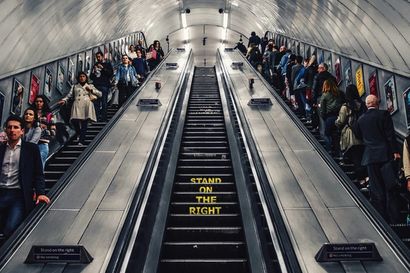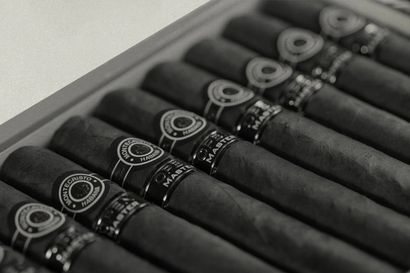A bead of sweat is rolling down my forehead. The sun beats down as it drops from my brow and falls into the glass of dark rum I’m gently turning between my thumb and forefinger. It is February. It is Cuba. It is 31 degrees.
Under the far-reaching boughs of a mango tree, I am drinking at two ‘o’ clock in the afternoon in a rural Cuban restaurant – although the establishment barely merits that title. The kitchen is a half-built shed, my chair a steel beam propped up by breeze blocks, and my fellow diners a small cadre of squawking chickens.
But that’s the way they like it. Not the chickens – rather the employees of the local rum distillery. This nameless eatery, miles from the nearest town, may be licensed as an official restaurant, yet it serves – almost exclusively – the distillers, blenders and bottlers of Cuba’s most spirited spirit: Havana Club rum.
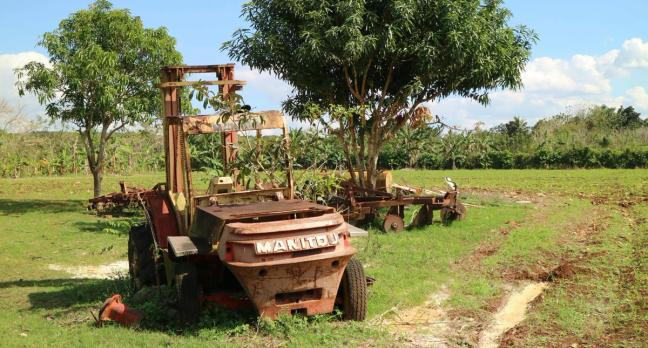
A pig roasts on a vast homemade barbecue, and dogs wander freely about my feet as Rudolfo, the softly-spoken proprietor, explains that the large sheet of metal acting as a table-top is the same steel used to build the rum distillery’s stills.
Rum is the lifeblood of Cuba. It sits in the cupboards of every house and atop every drinks menu, enjoyed by the young and the old alike. And these workers, who fill up barrels and bottles at the North Cuban distillery, in turn fill themselves up with Rudolfo’s roasted yuca, pulled pork and plantain chips. It’s a rustic meal, but one I’ve just enjoyed nonetheless.
This particular restaurant may be basic – it sits amidst a small jungle that snakes its way up through rusting agricultural equipment – but I am acutely aware that Cuba, for the most part, is rapidly outgrowing its reputation of rural simplicity. So, as I drain my drink and board a bus back to Havana, I reflect on the future of this rum-soaked, ramshackle and completely entrancing island.
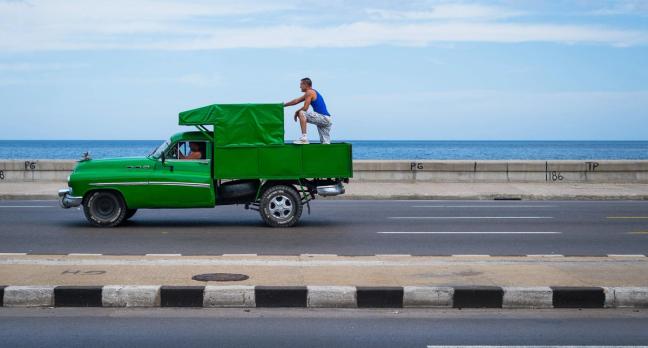
A complex country, Cuba has resisted change for many decades. But, several years ago, trade embargoes between the Caribbean nation and other countries – most notably the United States – were relaxed to allow for an increase in travel and trade. Government-issued permits were no longer required to leave the country, political prisoners were released and returned home, and just last November, Fidel Castro, the iconic revolutionary leader of modern Cuba, passed away.
As a result, Cuba has begun to modernise – not that these changes are evident out here in the countryside. Outside the major cities, it is business as usual. Away from the heady urban sprawl of Havana, the bus carries me past lush fields and thickets of swaying palms. City-bound on cement slab roads, egrets eye us from atop languid cows. Municipal workers, the only figures we pass, seem oblivious to the changes coming to Cuba as they cut back the grass on the highway embankments – with machetes.
I reflect on the future of this rum-soaked, ramshackle and completely entrancing island
Tourism may not be new to Cuba, but the industry has grown exponentially over recent years. With the embargo lifted, thousands have been attracted to the island – and the influx of visitors is starting to show. The country now walks a tightrope, caught in a balancing act between pandering to the tastes of tourists, and trying to retain the charm and tradition that attracted these visitors to Cuba in the first place.
Part of this problem is a lack of accommodation. The major hotels are state-owned and filled to capacity all year round. As such, the keys in my pocket are not for a room in the Hotel Nacional or Melia Habana, but rather for one of the many ‘homestays’ that have sprung up to handle the holidaymakers. Essentially bed-and-breakfasts, these low-budget alternatives promise a genuine and culturally-rich insight into Cuban life – but only if you like cold showers.
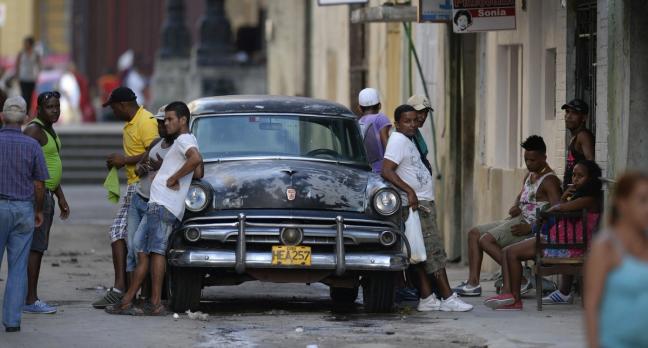
My homestay, a single-storey house in the West Havana district of Vedado, is owned by Leonardo Reyes de Dios, a man who makes up in heart what he lacks in teeth. The elderly Cuban lived with his friend Ibelis, several angry dogs, and Ibelis’ father – a man who sat so close to the television when the baseball was on that I feared a rogue ball might actually hit him.
Yet, despite inevitably drawing cries of pain from some tourists, the lack of WiFi, safe drinking water and adequate air conditioning will pale into insignificance once you step outside of your door. When I had first explored the city several days earlier, all the mobile phone signal in the world couldn’t have tempted me to take my phone out of my pocket. Except to take pictures, that is.
As I strolled the curious capital of this country, I became more and more intensely aware that there is nowhere else quite like Havana left in the world. Simply put, it is intoxicating – and that’s before I even touched the rum.
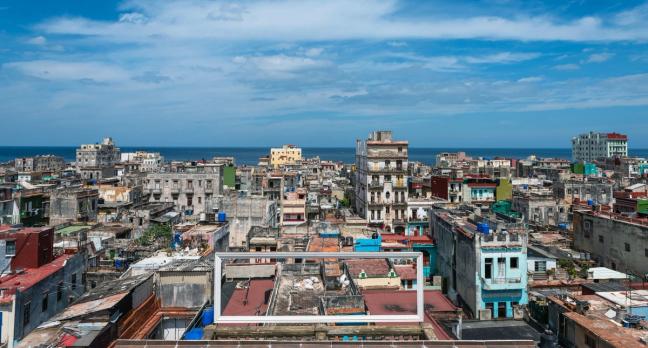
I saw pastel paint flake from the Spanish colonial architecture like snow. 1950s-era saloons crashed through the streets. Fruit sellers pushed carts stacked high with guava, bananas and tropical papaya. A sleepy Cuban street performer played ‘The Girl from Ipanema’ on a piccolo.
I smelt rich cigar smoke, burning engine oil and thick, old rugs. People stood in long queues to use payphones and even longer queues to withdraw cash from the banks. Havana may be a city living in the days of black-and-white, but it is a place of spectacular colour. Red snapper, white rum and black fumes. Vivid green limes and the dusky yellow of faded taxi cabs.
Buses barrelled past stuffed with commuters, and those who couldn’t squeeze on grabbed breakfast from a roadside shack – paying pennies for a bread roll and sharing apple juice from a chipped glass. Cats climbed onto balconies, motorbikes with sidecars shot across intersections and fat cigar stubs sat pretty in sandy roadside ashtrays.
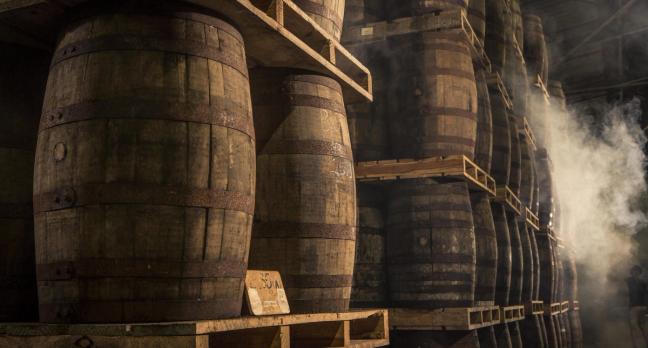
Cigars, like rum, are an integral part of Cuban culture. And, although the rest of the world has curbed its Cohiba consumption for the sake of health, medical science doesn’t quite seem to have made it to the streets of Havana yet. Ten per cent of all Cuban exports take the form of these tightly-rolled, tobacco-filled ‘habanos’, and the second largest cigar factory can be found in the centre of the capital.
Upon stepping inside the H. Upmann factory, I was confronted by a huge Cuban flag – 20 feet of sagging silk hanging four storeys high in the atrium. Up to 7,000 cigars a day roll out of the factory, with 5 types of leaf – from filler to binder – used by workers to create up to 150 ‘habanos’ per shift.
1950s-era saloons crashed through the streets. Fruit sellers pushed carts stacked high with guava, bananas and tropical papaya. A sleepy Cuban street performer played ‘The Girl from Ipanema’ on a piccolo
But, considering the modernisation sweeping across Cuba, there was something a little too old school about the factory. As I walked around, over strewn cigar butts and tobacco leaf offcuts, the workers tried to sell me cigars underhand. Wearing baseball caps and smoking as they nimbly rolled Cohibas, Partargas and Montecristos into existence, I was told that the workers are given five free cigars at the end of every shift – extras they are encouraged to sell to supplement their salaries.
Fans whirred overhead as the stogies stacked up, and I was refused both the information about how much the workers were paid, and an explanation of why some seemed so curiously young. A patriarchal figure frequently reads to the room, as many of the workers can’t read themselves – despite Cuba having one of the highest literacy rates in the world – at 99.8%.

I got the feeling that something less than reputable was going on in the H. Upmann factory. But, for all the literal and figurative smoke blowing, it was clear that this is one industry where the country’s newfound progress will be welcome.
The positive changes brought about by Cuba’s modernisation are numerous, but these benefits are tempered by the jobs and businesses that will become obsolete once the country catches up. Down the bustling street from the cigar factory was one such victim; the studio that once printed the revolution’s propaganda posters.
Now, the studio is quiet. When I walked in, the machines were still, and a silent black-and-white film played on a crackly television in the corner. Laurel and Hardy darted animatedly about the screen, but the workers were taking their time. After the rebel victory, this space became the workshop of the Institute of Cuban Cinema. These days, it is used for graphic design and the printing of album covers – much less provocative.
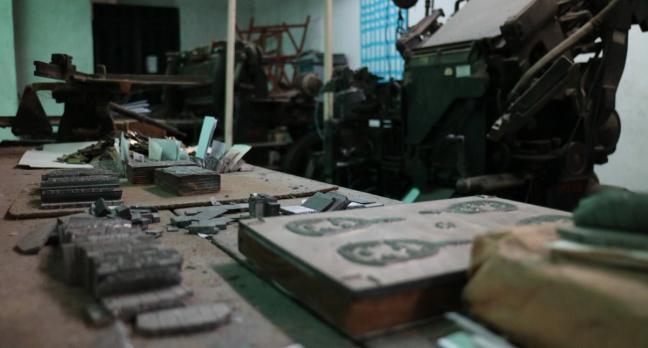
But, although the revolution is over, political unrest endures in Cuba. Locals say that police arrest those singing protest songs to this day. Even Castro’s final years were peppered with a series of strange political stand-offs.
Last decade, the American embassy building by the Malecon – or sea wall – installed a scrolling screen to display statements and news that belittled the national regime. Castro, with no power over US soil, took the innovative step of erecting 138 individual flagpoles around the building instead – and flew black flags to obscure the screen.
Times have changed, and it has been years since the last propaganda poster flew out of the studio. Instead, the machines are left to groan indignations of underuse. The television stuttered as a man sitting on a bench used his credit card to eat a pint of ice cream.

The one dynamic presence in the old studio was Edel Rodríguez, a hip young designer who zipped about the space on rollerblades. As one of the rising stars of the capital’s art scene, Rodríguez told me how Havana Cultura – an initiative for the promotion of contemporary Cuban culture backed by Havana Club Rum – is breathing new life into old institutions.
Other benefactors include Acosta Danza, Carlos Acosta’s exclusively Cuban ballet company, and Galeria Taller Gorria, an art space in a gentrified area of Havana. Upon visiting said gallery, Adán Perugorría LaFuente, the senior curator, revealed that the neighbourhood was the capital’s red light district not one decade ago. In the time since, it has been transformed into one of the worst ganglands in miles and rendered completely desolate before becoming the affluent arts hub it is today.
The positive changes brought about by Cuba’s modernisation are numerous, but these benefits are tempered by the jobs and businesses that will become obsolete once the country catches up
The city is scattered with similar success stories, all bolstered by Havana Cultura. But, as is only to be expected in this country of contradictions, where some businesses have benefitted from modernisation, others have lost their way.
Several days before my lunch at Rudolfo’s, I had delved into the Old Town for a drink at El Floridita. A bastion of Cuban tradition, the bar sits on the corner of Obispo and Monserrate, and this year celebrates its bicentenary. But, despite being the favoured Cuban hangout of Ernest Hemingway, Ezra Pound and Graham Greene in the past, the historic cocktail bar seems to be struggling to adapt to the modern world.
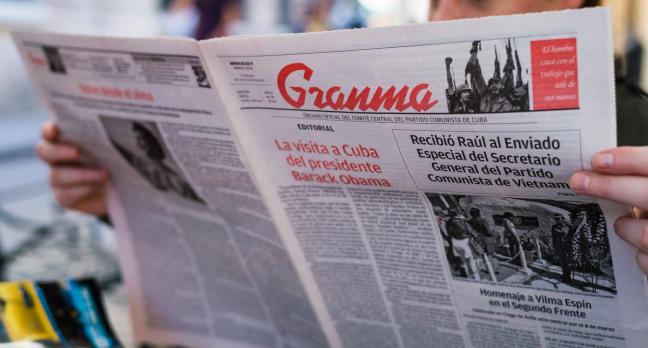
It was clear, as I sat with my rum-heavy Daiquiri in front of me, that even though my cocktail wasn’t watered down, the experience of drinking in El Floridita was. There is undoubtedly still a sparkle to this den of decadence, but tourism is taking its toll. A large man wearing a stars and stripes belt buckle bumps past me as I sip, as if to reinforce my point.
El Floridita is also, tellingly, one of Havana’s only WiFi hotspots. It has been invaded by the posing and pretentious MacBooks-in-Starbucks types – aspiring novelists tapping out their ‘masterpieces’ in the shadow of Hemingway, whose bronze statue props up the end of the bar.
Many of Cuba’s institutions, such as El Floridita, need to rail against progress to maintain their appeal and magic. Sadly, many have not. One that has – to the extreme – is La Guarida. An emblem of Havana, this dilapidated mansion is supported by joists and beams. Entire walls have completely given away, statues stand smashed and strings are strung across the rooms as if the whole place is rigged for demolition. But La Guarida won’t be falling just yet – for it is one of the most famous paladars in Cuba.
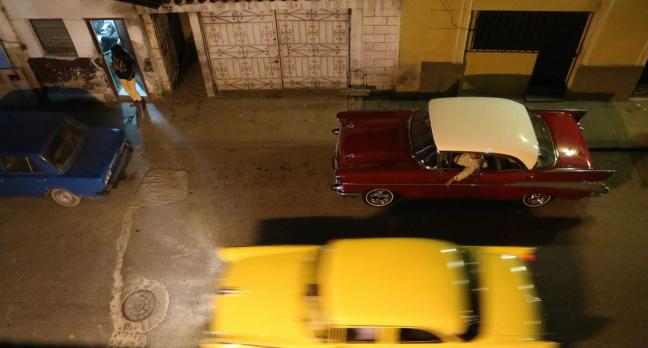
Paladars are the culinary equivalent of homestays. Like hotels, many of the official restaurants in Cuba are state-owned, forcing aspiring gastronomers to set up shop in their own houses or outbuildings. The number of seats should be limited, but in a city swarming with illegal taxi cabs and a burgeoning black market, another chair at the table is hardly something to quibble over.
After El Floridita, the austere honesty of La Guarida was refreshing – and the marlin tacos, lobster and rich chocolate delicious. With food finished, another couple of journalists and I snuck up to the roof – cocktails in hand. Up a metal spiral staircase we were met by the sight of the city and a sideways moon – the moon waxes and wanes from top to bottom by the equator.
We enjoyed our sobremesa – a traditional period of relaxation after a meal, during which diners enjoy a cigar or drink – and looked out over the moonlit capital. A patchwork city, Havana’s horizon is dotted with buildings old and new – the country’s cultural confusion no more evident than when viewed from above.
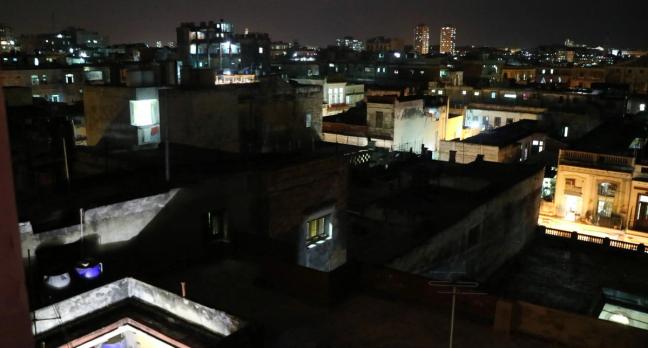
Thunder rumbled and our sobremesa was cut short. But these were not the only storm clouds gathering over Havana. Progress looms, and this frantic city’s cracks are starting to show.
The Dodges and Pontiacs and Chevrolets that drive the streets have been bastardised with generations of make-do repairs. A Gucci boutique will soon make its way onto the island – marking one of the first few forays of major brands and chains into Cuba. Even living statues are cropping up – the scourge of tourist traps the world over.
Thunder rumbled and our sobremesa was cut short. But these were not the only storm clouds gathering over Havana. Progress looms, and this frantic city’s cracks are starting to show
Soon, the floodgates will open to wash away the last few vestiges of individuality this country is clinging to.
This is a nation on the brink of cultural crisis. And, as the grassy fields give way to the sea, and my bus skirts the seafront, I wonder just how long Cuba has before it finally gives way to the modern world. Because, as we plunge back into the heart – the bellowing, colourful hive of Havana, it is clear that there is nowhere left like this in the world.

Stray dogs run circles in empty fountains. Elderly women in traditional dress smoke fat cigars from the front steps of brightly-painted houses. Horns blare, people sing and laundry flaps from open windows.
Simply put, this is a nation of old. Vinyl still spins. Classic cars are everyday drivers. WiFi is a dirty word. But not for long. The future is creeping in. And that may be a good thing, it may be bad. But this disorganised, muddled and unforgettable echo of the past has firmly – and irreversibly – pressed fast-forward on everything from its music to its motors.
So, if you want to catch this country before the country catches up, get here fast; for these are the last days of Cuba.

Become a Gentleman’s Journal Member?
Like the Gentleman’s Journal? Why not join the Clubhouse, a special kind of private club where members receive offers and experiences from hand-picked, premium brands. You will also receive invites to exclusive events, the quarterly print magazine delivered directly to your door and your own membership card.

